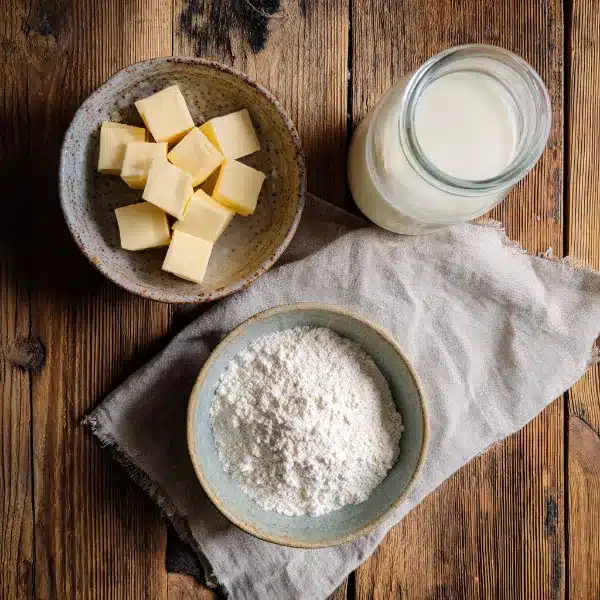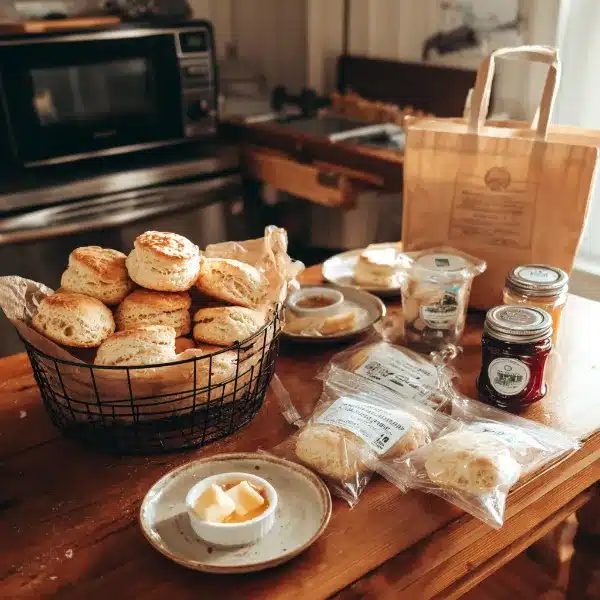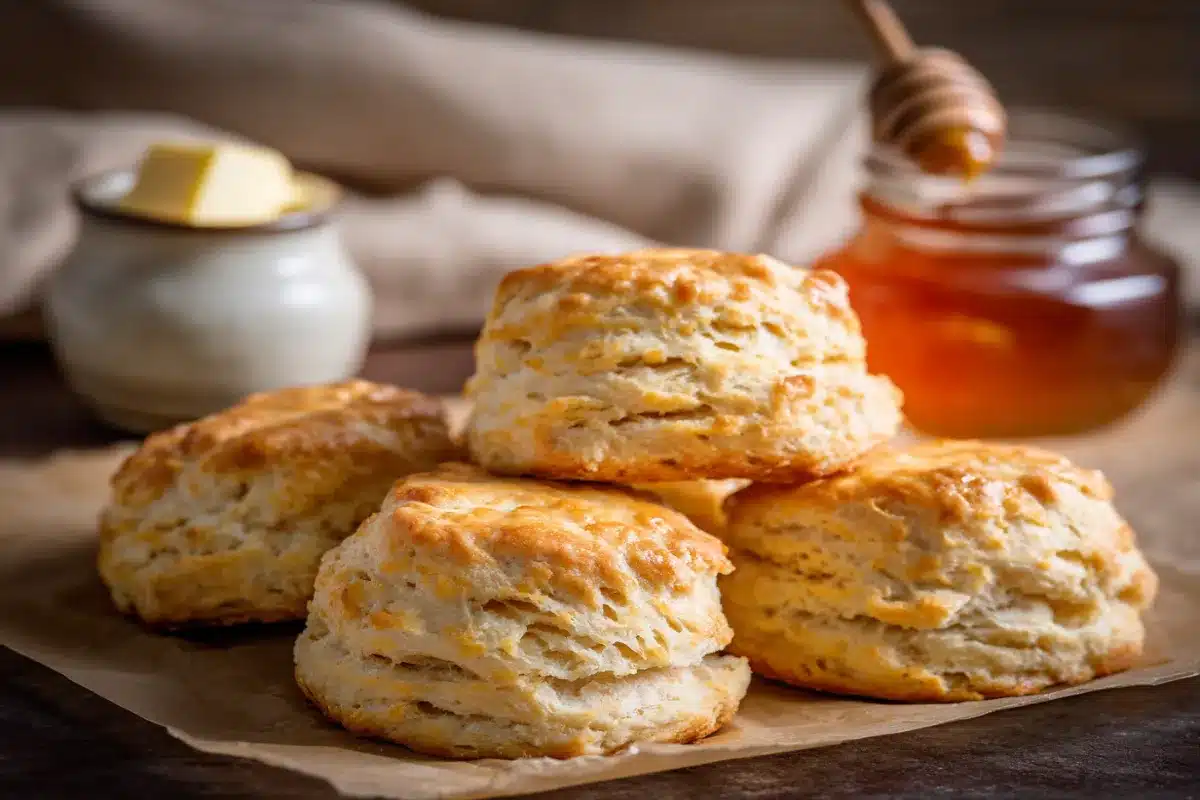3 ingredient biscuit recipe—these words carry more than just culinary ease. They represent comfort, creativity, and connection, all values at the heart of my kitchen. I’m Firdaous, a smiling Moroccan woman in my early 30s and the voice behind Family Feast Recipes. My journey began with a simple dream: to turn my love for cooking into a space where cozy, crave-worthy meals bring families closer—one warm bite at a time.
This blog grew from that dream, shaped by my heritage, my passion, and the joy I find in creating food that speaks to the soul. Inspired by the rich traditions of Morocco and the comforting dishes I create in my own kitchen, I’ve always believed food is a universal language of love.
That’s exactly why I’m so excited to share this 3 ingredient biscuit recipe with you. It’s not only one of the easiest recipes on this site—but one of the most rewarding. Whether you’re short on time, low on pantry supplies, or just craving something warm and buttery without the fuss, this recipe has you covered.
Table of Contents
Table of Contents
Understanding the Basic Biscuit Formula
The Science That Powers Every Biscuit
At first bite, a biscuit might feel like magic—but the magic is all in the method. Every great 3 ingredient biscuit recipe comes down to a simple but powerful trio: flour, fat, and liquid. These three elements, when balanced just right, produce that irresistible mix of crisp edges and a soft, fluffy center.
Here’s how each one plays its role:
| Ingredient | Purpose in the Dough | Typical Choices |
|---|---|---|
| Flour | Acts as the base and provides structure | Self-rising flour, or all-purpose flour + baking powder |
| Fat | Adds richness, flakiness, and tenderness | Butter, cream, shortening |
| Liquid | Binds the dough and activates leavening | Milk, heavy cream, or even buttermilk |
The secret to a good rise? Steam. When your dough hits the oven’s heat, moisture trapped inside turns to steam, puffing up your biscuits from within. Self-rising flour already includes leavening agents like baking powder and salt, making it a shortcut that still delivers fluffy results.
One golden rule: Don’t overmix. Stir just until combined. Overworked dough creates tough biscuits—and we’re going for tender, not tire tread.
Old-School vs. Modern: What’s Really Changed?
Classic biscuit recipes from Southern kitchens often use six to eight ingredients: butter, buttermilk, flour, baking soda, salt, and sometimes even sugar or eggs. They’re rich, flavorful, and timeless—but not always ideal when you’re short on time or pantry staples.
Enter the modern version. The 3 ingredient biscuit recipe distills the process down to its delicious core, giving you soft, golden biscuits in a fraction of the time.
Here’s a side-by-side to compare:
| Aspect | Traditional Biscuits | 3 Ingredient Biscuits |
|---|---|---|
| Ingredients Count | 6–8 | Just 3 |
| Time Required | Around 45 minutes | 15–20 minutes max |
| Skill Level | Moderate | Easy enough for first-timers |
| Taste Profile | Buttery, layered, complex | Light, fresh, easy to customize |
The modern 3-ingredient version often calls for:
- Self-rising flour, so you skip baking powder and salt.
- Heavy cream or cold butter, which doubles as the fat and part of the liquid.
- Milk or even a fizzy drink like Sprite, to add moisture and encourage rise.
These minimal bakes aren’t just easier—they’re versatile. Dress them up with cheese or honey, or keep them plain for pairing with jam or gravy. They’re ideal when you’re cooking with kids, prepping a quick breakfast, or trying to stretch ingredients at the end of the week.
for more recipes FOLLOW FACEBOOK
What Goes Into a 3 Ingredient Biscuit Recipe
Just Three Ingredients – But They Matter

The charm of any 3 ingredient biscuit recipe is its simplicity—but don’t let the low ingredient count fool you. These three components must work in perfect harmony. One misstep with the wrong flour, fat, or liquid can mean the difference between flat, tough biscuits and warm, golden pillows of flaky goodness.
Let’s unpack what each ingredient brings to the table—and how to make smart choices if you’re swapping things out.
1. Flour: Your Biscuit’s Backbone
Your flour determines your biscuit’s structure and rise. The top choice? Self-rising flour. It’s soft, low in protein, and already includes baking powder and salt, which simplifies your prep and guarantees fluffier results.
Don’t have self-rising flour? No problem.
Homemade Substitute
- 1 cup all-purpose flour
- 1 ½ teaspoons baking powder
- ¼ teaspoon salt
This DIY blend is a reliable backup, especially for home cooks working with pantry basics. Keep your measurements exact, and your biscuits won’t know the difference.
2. Fat: The Heart of Flaky Layers
Fat makes the magic happen. It coats the flour, creates delicate layers, and adds that rich mouthfeel we all crave in a biscuit. You have options, and each one creates a slightly different texture:
| Fat Type | Effect | Notes |
|---|---|---|
| Cold Butter | Flaky, layered | Grate or cube for best results |
| Heavy Cream | Moist, tender | Doubles as liquid and fat |
| Shortening | Tall rise, mild flavor | Ideal for ultra-soft biscuits |
Cold butter is a favorite for good reason—it melts in the oven, releasing steam that separates the dough into gorgeous layers. But if you’re after a softer, creamier crumb, heavy cream is a smart one-ingredient hack that pulls double duty.
3. Liquid: The Binding Force
Without liquid, you’ve got nothing but dry flour and fat. The right liquid ties everything together and reacts with the leavening to help your biscuits rise.
Common choices include:
- Milk – Mild and neutral, great for everyday baking
- Buttermilk – Slightly acidic, adds tang and tenderness
- Cream – Extra rich and doubles as fat
- Soda (like Sprite) – Surprisingly effective for a soft, sweet biscuit
Whichever liquid you choose, make sure it’s cold. This keeps the fat from melting too early, which means taller, fluffier biscuits once they hit the oven.
Smart Pairings to Nail the Texture You Want
Not all 3 ingredient biscuit recipes are created equal. Want flaky? Go butter-heavy. Prefer tender and moist? Cream’s your friend. Here’s a quick guide to help:
| Flour | Fat | Liquid | Perfect For |
|---|---|---|---|
| Self-rising | Cold Butter | Milk | Traditional flavor and texture |
| Self-rising | Heavy Cream | Heavy Cream | Moist, rich, and soft |
| DIY SR (All-purpose mix) | Shortening | Buttermilk | Southern-style tangy biscuits |
Each combo offers a slightly different bite, so play around and find what fits your taste best. The flexibility of this recipe is part of why it’s so beloved—no two batches have to be the same.
Step-by-Step Guide to Making Perfect 3 Ingredient Biscuits
Skip the Fuss – Here’s All You Really Need
One of the best parts about a 3 ingredient biscuit recipe is that it doesn’t require any fancy kitchen gadgets or pro skills. No mixers, processors, or special pans. If you’ve got a mixing bowl and a little space to work, you’re ready to roll.
Here’s a simple list of tools that get the job done without cluttering your counter:
| Tool | What It’s For |
|---|---|
| Large mixing bowl | Combine ingredients gently without toughening the dough |
| Fork or pastry cutter | To blend cold fat into the flour (if using butter or shortening) |
| Round cutter or drinking glass | Helps shape biscuits evenly and cleanly |
| Standard baking sheet | Line with parchment paper or lightly grease it |
| Oven | Set to 425°F (218°C) to guarantee a quick, fluffy rise |
Optional but helpful: A bench scraper for flipping dough and a wire rack for cooling.
How to Make It Happen – The Foolproof Biscuit Process

Even if this is your first time baking from scratch, don’t sweat it. This recipe is simple enough for kids to help with and still impresses guests at brunch.
Step 1: Heat It Up
Begin by preheating your oven to 425°F (218°C). A hot oven is essential—it kickstarts the leavening and helps those biscuits puff up like little clouds. While that’s heating, prep your baking sheet with parchment paper or a light grease.
Step 2: Combine Dry and Fat
If you’re using cold butter or shortening, toss 2 cups of self-rising flour into a large bowl. Cut in 1/2 cup of the fat using your fork or cutter until it looks like coarse crumbs. You should still see tiny pea-sized bits of fat—they’ll help create layers.
Skipping the butter? If you’re going with heavy cream as your all-in-one fat and liquid, go straight to the next step.
Step 3: Add Your Liquid of Choice
Pour in 3/4 to 1 cup of your preferred liquid: milk, buttermilk, or heavy cream. Stir slowly with a spoon or spatula. The dough should come together without being too wet or dry—shaggy is the goal here.
Tip: Resist the urge to overmix. Overworking the dough will turn your soft biscuits into dense, chewy pucks.
Step 4: Shape with Care
Lightly flour your work surface and dump the dough out. Pat it down gently, then fold the dough over itself two or three times. This folding adds flaky layers—no kneading required.
Flatten to about 1/2 to 3/4 inch thick. No need for a rolling pin—your hands are more than enough.
Step 5: Cut Like a Pro
Using your cutter (or an upside-down glass), press straight down into the dough—no twisting. Twisting seals the edges and prevents proper rising. Arrange biscuits close together on your tray if you want soft sides, or space them out for crisper edges.
Step 6: Bake ‘Em Golden
Slide your tray into the hot oven and bake for 12 to 15 minutes, or until the tops turn a beautiful golden brown. The aroma will fill your kitchen and your heart.
Optional finish: Brush the tops with melted butter as soon as they come out. This adds flavor, shine, and that irresistible fresh-baked smell.
Common Troubles – Solved
Even simple recipes can go sideways. Here’s how to troubleshoot like a kitchen pro:
| Issue | What to Do |
|---|---|
| Dough is too sticky | Add a spoonful of flour and gently mix again |
| Dough feels too dry | Mix in a small splash of milk or cream to loosen it up |
| No rise in biscuits | Check the freshness of your flour and make sure your oven is fully preheated |
Mary Berry 3 Ingredient Cookies vs. American Biscuits
Two Classics, One Simplicity: But They’re Not the Same
At first glance, a 3 ingredient biscuit recipe might sound like it has a lot in common with Mary Berry’s famously simple cookies. After all, both use minimal ingredients, rely on pantry staples, and can be whipped up quickly. But dig a little deeper, and you’ll find they’re from two very different baking traditions—with their own textures, flavors, and fans.
Let’s explore the differences (and a few surprising similarities) between these two minimal-ingredient marvels.
What Are Mary Berry’s 3 Ingredient Cookies, Exactly?
If you’re not already familiar, Mary Berry is one of Britain’s most beloved bakers—known for her role on The Great British Bake Off and her homey, no-fuss recipes. Her 3 ingredient cookie recipe is one of her most shared for good reason. It typically includes:
- Butter
- Flour
- Sugar
That’s it. The result is a tender, shortbread-style cookie that melts in your mouth. The texture is crumbly and rich, thanks to the butter, and there’s no need for eggs or baking powder. The sweetness is subtle, making them ideal for pairing with tea or adding chocolate chips, nuts, or citrus zest.
These cookies are baked low and slow, usually around 325°F (160°C), until just set and golden around the edges. They don’t rise or puff—they hold their shape and develop a crisp, buttery bite.
How American Biscuits Are Totally Different
Now let’s switch sides of the Atlantic.
In the U.S., a 3 ingredient biscuit recipe refers to something completely different. American biscuits aren’t sweet cookies—they’re soft, flaky, bread-like rounds, often served warm with butter, jam, or smothered in sausage gravy. Think of them as a cross between scones and dinner rolls.
What’s in them?
- Self-rising flour
- Cold butter or cream
- Milk or buttermilk
Unlike Mary Berry’s cookies, American biscuits rely on steam and chemical leavening to puff up during baking. They rise tall, develop tender layers, and are served with savory meals or as a breakfast staple across the South.
Side-by-Side Comparison
| Feature | Mary Berry Cookies | American 3 Ingredient Biscuits |
|---|---|---|
| Origin | United Kingdom | United States (Southern cooking) |
| Texture | Crumbly, crisp | Flaky, soft, tender |
| Flavor Profile | Sweet and buttery | Savory or neutral |
| Common Ingredients | Butter, sugar, flour | Self-rising flour, fat, liquid |
| Baking Style | Cookie sheet, low temp | High heat, quick rise |
| Served With | Tea, coffee | Jam, gravy, eggs, meats |
Can You Blend the Two Worlds?
Absolutely. While they serve different purposes, both recipes are rooted in one timeless idea: simplicity done right. With just a few pantry staples and the right technique, you can create baked goods that feel indulgent without being complicated.
Want a twist? Try adding a touch of sugar to your biscuit dough and serving them with jam or whipped cream. Or bake Mary Berry’s cookies with a pinch of sea salt and pair them with sharp cheese for a gourmet snack.
Easy Variations to Try with Just 3 Ingredients
Creative Without Compromise – Flavor Upgrades that Stick to Three
One of the most exciting things about a 3 ingredient biscuit recipe is how flexible it is. Even with a strict three-ingredient limit, there’s still plenty of room to play with flavor. Whether you lean sweet or savory, it’s totally possible to shake things up—no extra pantry raid required.
In fact, some of the best flavor combinations happen when you do less, not more. The key is swapping smart, not adding extra.
Sweet Twists for Breakfast and Brunch
Want your biscuits to lean more dessert than dinner? Here are a few creative (but easy) ways to go sweet without crossing that three-ingredient line:
1. Honey Cream Biscuits
- Swap the milk or buttermilk for heavy cream mixed with a tablespoon of honey.
- This brings moisture, fat, and sweetness in one move.
Perfect For: Morning tea, weekend brunch, or serving with fruit and whipped cream.
2. Chocolate Chip Drop Biscuits
- Use self-rising flour, heavy cream, and mini chocolate chips.
- Chocolate adds flavor but doesn’t count as a structural ingredient—still only three real players.
Try it when: You need something fast and crowd-pleasing for kids or surprise guests.
3. Cinnamon Sugar Biscuit Bombs
- Use cold butter cut into self-rising flour, and brush tops with cinnamon sugar before baking.
- The sugar doesn’t go in the dough—it goes on top. Still a legit 3-ingredient bake.
Great with: Coffee, chai, or late-night snack runs.
Savory Twists for Dinner or Snacking
If you’re after something heartier—or just want a biscuit that can hold its own next to eggs, chili, or soup—these savory swaps are game changers:
1. Cheddar Cream Biscuits
- Self-rising flour + shredded cheddar + heavy cream
- Cheese replaces the fat while adding sharpness and richness. Stir and bake—done.
Pro tip: Use sharp cheddar or pepper jack for extra flavor.
2. Garlic Butter Biscuits
- Cold garlic butter + flour + buttermilk
- Pre-mix garlic into your butter and use that instead of plain fat. Adds a punch without adding an extra ingredient.
Best with: Pasta dishes, roast chicken, or beef stew.
3. Herb-Infused Drop Biscuits
- Use heavy cream that’s been steeped with rosemary or thyme
- Strain the herbs out before mixing. The flavor remains, and your ingredient count stays clean.
Serve with: Holiday roasts or creamy soups.
Flavor Swap Cheat Sheet
Here’s a quick reference table for on-the-fly creativity:
| Base | Swap Option | Flavor Result |
|---|---|---|
| Milk | Heavy cream + honey | Sweet and rich |
| Butter | Garlic butter | Savory and bold |
| Cream | Add cheddar | Cheesy, tangy |
| Milk | Infused with herbs | Subtle and earthy |
| Plain dough | Topped with cinnamon sugar | Sweet crunch |
You don’t need a list of ten ingredients to make memorable biscuits. With a few smart swaps and the same simple base, you can create everything from brunch-ready bites to savory snacks that feel gourmet.
Troubleshooting Common Biscuit Baking Problems
Even Simple Recipes Can Go Sideways – Here’s How to Save Your Bake
Let’s be honest—baking a 3 ingredient biscuit recipe might sound foolproof, but anyone who’s ever pulled out flat, dry, or rock-hard biscuits knows: things can still go wrong. The good news? These mistakes are almost always fixable—or preventable.
Whether your biscuits spread like pancakes or come out dry as dust, this guide will walk you through the most common issues and how to fix them without starting over.
Problem #1: My Biscuits Didn’t Rise
What Went Wrong:
Flat biscuits usually point to one of two issues—either your oven wasn’t hot enough, or your leavening power was weak.
Fix It:
- Check your flour. Self-rising flour loses its strength after about six months. If it’s expired, your biscuits won’t rise.
- Preheat that oven. If it’s not fully heated to 425°F (218°C) when the tray goes in, your biscuits won’t get the quick blast of heat they need to puff up.
Pro Tip: Use an oven thermometer. Most ovens run hotter or cooler than they say.
Problem #2: They Came Out Hard or Dry
What Went Wrong:
Overmixing is the number one culprit. Working the dough too much develops gluten, which makes biscuits chewy instead of tender. Too little moisture can also dry them out.
Fix It:
- Mix just until the dough holds together—no kneading needed.
- Add more liquid if your dough feels crumbly or too stiff. A tablespoon or two can make all the difference.
Pro Tip: Stick with cold fat and cold liquid. Warm ingredients melt prematurely, leading to dense, greasy biscuits.
Problem #3: Biscuits Are Spreading or Merging
What Went Wrong:
Warm dough, soft fat, or overhandling can cause biscuits to lose structure and flatten out.
Fix It:
- Chill the shaped biscuits in the fridge for 10–15 minutes before baking.
- Make sure your butter or cream is straight from the fridge when you start.
Bonus Tip: Cut straight down with your biscuit cutter—don’t twist! Twisting seals the edges and limits rise.
Problem #4: They Taste Bland
What Went Wrong:
With only three ingredients, every element counts. Using plain flour without salt or leavening is a recipe for bland results.
Fix It:
- Always use self-rising flour (or make your own with baking powder + salt).
- If you’re still not satisfied, try swaps like buttermilk for tang or cheddar for savory depth (see Part 6).
Flavor Hack: Brush with melted garlic butter or honey while hot to level-up flavor without breaking the 3-ingredient rule.
Quick Troubleshooting Table
| Problem | Likely Cause | Quick Fix |
|---|---|---|
| Flat Biscuits | Low heat, old flour | Preheat oven, check flour freshness |
| Dry Texture | Overmixed dough, not enough liquid | Stir gently, add extra cream/milk |
| Spread Too Much | Warm fat or dough | Chill dough before baking |
| Bland Flavor | Skipped self-rising flour | Use self-rising or add salt/leavening |
Practice Makes Perfect (And Biscuits Forgive Easily)
The truth is, even “imperfect” biscuits are still pretty good. With a little attention to technique, your next batch will be golden, tall, and exactly what you had in mind.
Nutrition, Cost, and Time Comparison
Why This 3 Ingredient Biscuit Recipe Wins on Every Front
We’ve talked about the taste. We’ve covered the steps. But if you’re still wondering whether this 3 ingredient biscuit recipe fits into your lifestyle—whether you’re watching your wallet, your time, or your nutrition—it absolutely does.
Let’s break it down and show why this is one of the most practical baking choices you can make.
Nutrition Breakdown: What’s Really In Your Biscuit?
With only three ingredients, this biscuit doesn’t carry the long list of preservatives or additives you’ll find in store-bought versions. It’s real food made with real ingredients—and you control what goes in.
Here’s an average nutritional profile for one medium-sized biscuit (using self-rising flour, butter, and milk):
| Nutrient | Amount per Biscuit |
|---|---|
| Calories | 160–180 kcal |
| Fat | 8–10g |
| Carbohydrates | 20–22g |
| Protein | 3–4g |
| Fiber | <1g |
| Sodium | 300–400mg |
Healthier Swaps (Still Keeping It Simple)
- Use Greek yogurt in place of cream for added protein
- Try plant-based milk or butter to make it dairy-free
- Use whole wheat self-rising flour for a fiber boost
Even with its comforting richness, this recipe can be adapted to fit lighter eating styles—without losing that melt-in-your-mouth magic.
Time-Saver: From Mixing Bowl to Table in 20 Minutes

Busy schedule? You’re not alone. That’s why this recipe’s short prep and bake time make it a kitchen lifesaver.
| Task | Time |
|---|---|
| Prep & Mixing | 5–7 minutes |
| Shaping | 3 minutes |
| Baking | 12–15 minutes |
| Total Time | ~20–25 minutes |
That’s faster than most delivery apps can get to your door—and a whole lot more satisfying.
Budget Breakdown: Biscuits on a Dime
You don’t need a grocery haul to make these. In fact, you probably already have everything you need.
Let’s do the math based on average U.S. grocery prices:
| Ingredient | Cost per Batch |
|---|---|
| 2 cups self-rising flour | $0.40 |
| 1/2 cup butter or 3/4 cup cream | $0.80 |
| 3/4 cup milk or buttermilk | $0.30 |
| Total | $1.50–$1.60 for 8 biscuits |
That’s less than 20 cents per biscuit. Compare that to store-bought brands or bakery prices, and you’re looking at major savings without sacrificing quality.
Why This Recipe Deserves a Spot in Your Rotation
Let’s sum it up:
| Category | 3 Ingredient Biscuit Recipe |
|---|---|
| Time | Fast and flexible |
| Cost | Incredibly budget-friendly |
| Nutrition | Whole, customizable ingredients |
| Difficulty | Beginner-proof |
| Taste | Buttery, flaky, satisfying |
Whether you’re feeding a crowd, planning for leftovers, or just craving something cozy, this 3 ingredient biscuit recipe brings together everything we love about home cooking: comfort, ease, and simplicity.
Conclusion: The 3 Ingredient Biscuit Recipe – Simple, Versatile, and Unbeatable
When it comes to easy comfort food, nothing beats a 3-ingredient biscuit recipe. It’s living proof that homemade baking doesn’t need a mile-long list of ingredients or hours in the kitchen. Whether you’re whipping up a quick brunch, serving biscuits alongside soup for dinner, or just craving a warm bite in the afternoon, this recipe never lets you down.
In this guide, we’ve explored what makes biscuits light and fluffy, looked at different styles—from Mary Berry’s cookies to Southern staples—and tackled common baking slip-ups. The real beauty of this recipe? It’s incredibly flexible. You can enjoy it as-is or get creative with sweet or savory add-ins—either way, it all starts with just three ingredients you probably already have in your pantry.
Frequently Asked Questions About the 3 Ingredient Biscuit Recipe
What is the basic biscuit formula?
The basic biscuit formula includes flour, fat, and a liquid—usually milk or buttermilk. These three ingredients work together to create soft, flaky layers. The fat (like butter or cream) adds richness and texture, while the liquid binds the dough. Mastering this simple ratio is the secret behind any easy 3 ingredient biscuit recipe.
What are Mary Berry’s 3 ingredient cookies?
Mary Berry’s 3 ingredient cookies are a minimalist British treat typically made with butter, sugar, and flour. They differ from American-style biscuits, as they’re more like buttery shortbread cookies. While both recipes share simplicity, Mary Berry’s version leans sweet and crumbly—perfect for tea time.
What are the ingredients in making biscuits?
At their core, biscuits are made with just three ingredients: self-rising flour, heavy cream or buttermilk, and butter or shortening. These pantry staples form the base of many biscuit recipes. Some modern versions also use Greek yogurt, sour cream, or plant-based fats as substitutes, especially in dairy-free variations.
What biscuits are easy to make?
3 ingredient biscuits are among the easiest to make. They’re beginner-friendly and don’t require special tools or skills. Drop biscuits, cream biscuits, and Mary Berry’s 3 ingredient cookies are perfect examples. Just mix, shape, and bake—no yeast or long prep times needed.

3 Ingredient Biscuit Recipe
- Total Time: 25 minutes
- Yield: 8 biscuits 1x
Description
This 3 ingredient biscuit recipe is your go-to for soft, fluffy, and buttery biscuits made in just 25 minutes—no mixer, no fuss. Using only self-rising flour, heavy cream, and butter, these homemade biscuits come together fast and bake up golden every time. Whether you’re a beginner or seasoned baker, this simple recipe delivers perfect results without complicated steps or fancy tools. Ideal for breakfast, as a side with dinner, or as a base for sweet and savory snacks, these biscuits are endlessly customizable and sure to become a staple in your kitchen.
Ingredients
2 cups self-rising flour (or all-purpose with 1 tbsp baking powder + 1/2 tsp salt)
1 cup heavy cream (cold)
1/4 cup unsalted butter, melted (plus extra for brushing)
Instructions
Preheat your oven to 450°F (232°C). Line a baking sheet with parchment paper or lightly grease it.
In a large bowl, add the flour and pour in the cold heavy cream. Stir with a spoon until just combined—do not overmix.
Turn the dough onto a floured surface. Gently pat it out to about 3/4-inch thick.
Use a biscuit cutter or round glass to cut out biscuits. Re-roll scraps as needed.
Place biscuits on the baking sheet, close together for soft sides or spaced apart for crispier edges.
Brush tops with melted butter and bake for 12–15 minutes, until golden brown.
Remove from oven and brush with more butter, if desired. Serve warm.
Notes
Room Temp: Store in an airtight container for up to 2 days.
Freezer: Wrap in foil and freeze up to 1 month. Reheat in oven at 350°F for 8–10 minutes.
- Prep Time: 10 minutes
- Cook Time: 15 minutes
- Category: Baking, Breakfast, Side
- Method: Baking
- Cuisine: American
Nutrition
- Serving Size: 1 biscuit
- Calories: ~220 kcal
- Sugar: ~1 g
- Sodium: ~350 mg (depends on the salt in the self-rising flour)
- Fat: ~13 g
- Saturated Fat: ~8 g
- Unsaturated Fat: ~4.5 g
- Trans Fat: ~0 g
- Carbohydrates: ~22 g
- Fiber: ~0.7 g
- Protein: ~3 g
- Cholesterol: ~35 mg
for more recipe follow pinterest.

